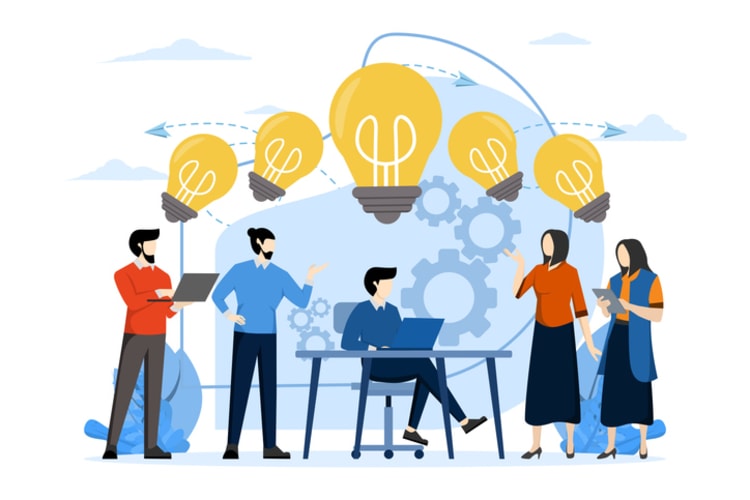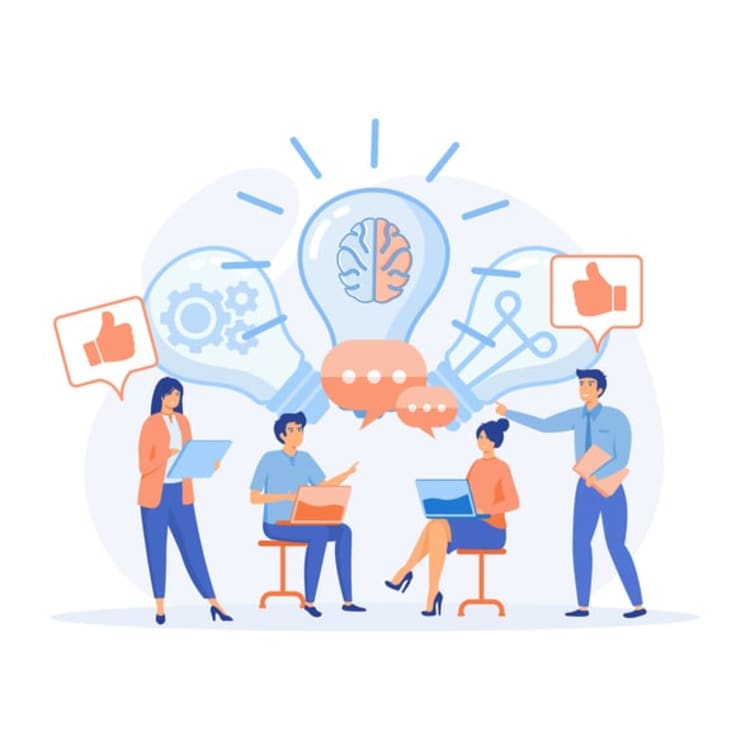In our rapidly evolving world, effective collaboration has never been more crucial. With diverse teams working across time zones and remote work becoming the norm, mastering collaboration skills is a must-have for success in 2024. In this blog post, we’ll explore the importance of workplace collaboration and the essential skills needed to unlock its power, such as active listening, emotional intelligence, and conflict resolution. We’ll also discuss overcoming collaboration challenges, implementing collaboration tools and strategies, and fostering a collaborative company culture. Let’s dive into the world of collaboration and unleash its full potential in your workplace!
Key takeaways
- Workplace collaboration is essential for unlocking benefits such as creativity, productivity and team building.
- Team members can unlock their potential by mastering essential skills like active listening, emotional intelligence and conflict resolution.
- Organizations can develop a collaborative company culture through setting clear expectations, promoting openness & transparency and recognizing success.
The importance of workplace collaboration

The key to unlocking myriad advantages within the workplace lies in collaboration skills. A collaborative environment not only stimulates innovation and amplifies productivity but also enhances team satisfaction. The rewards of collaboration are evident in terms of creativity, productivity, and team building. When team members collaborate, they have the opportunity to learn from each other, contributing to individual and professional growth.
Trust and diversity are pivotal to workplace collaboration in our increasingly interconnected world. Trust allows individuals to provide and receive constructive feedback, work towards a shared goal, and access necessary resources and opportunities to collaborate effectively. Moreover, diverse teams bring forth a wider array of ideas and solutions, sparking creative problem-solving and novel approaches. Diverse teams provide a range of perspectives which support better understanding of markets, customer needs and current trends. This leads to improved insights into different aspects of the industry.
Boosting productivity
Productivity increases with successful collaboration. By streamlining processes, eliminating redundant efforts, and encouraging a sense of collective accountability among team members, collaboration paves the way for a more efficient and productive workplace. Cross-training, for instance, offers team members the chance to learn skills and tasks beyond their usual roles, fostering better collaboration and understanding of each other’s capabilities.
However, collaboration is not without its challenges. Shy or less confident team members, diverse communication styles, and remote work dynamics may all pose hurdles in the path to effective collaboration. To address these issues, leaders should establish inclusive meeting and conversation guidelines, foster an environment where failure is not feared, leverage work management software, and promote positivity, encouraging the generation of new ideas.
Driving innovation
Innovation is driven by collaborative teams. Through the synthesis of varied perspectives, abilities, and experiences, teams can create novel solutions and propel the organization forward. Protiviti’s Global Innovation Challenge is a great example of collaborative innovation. It involves a working session, where local offices come together to think of solutions to a question posed by the leadership team. These ideas are then evaluated by the Innovation Task Force, showcasing the power of collaboration in driving innovation.
Debate is often the catalyst for creativity in collaborative settings, and having good communication skills is essential for effective debating. By fostering an environment where team members feel comfortable sharing their ideas and engaging in constructive debates, organizations can harness the power of collaboration to fuel innovation and stay at the cutting edge of their industry.
Enhancing employee engagement
Employee engagement is significantly enhanced by collaboration. By promoting a sense of belonging, purpose, and personal growth among team members, collaboration helps create a more satisfied and motivated workforce. Effective verbal communication is crucial in fostering this sense of belonging, allowing team members to express their thoughts and opinions clearly and openly.
Collaboration in the workplace offers various advantages for employee engagement, such as:
- Increased motivation
- Better communication
- Heightened creativity and innovation
- Reinforced relationships
- Increased learning and development
- Increased productivity
Team leaders play a vital role in facilitating and promoting collaboration, ensuring that the benefits of a collaborative work environment are realized and shared among all team members, including other team members.
Essential collaboration skills for success

The full potential of teamwork and problem-solving can be unlocked by mastering essential collaboration skills. Active listening, emotional intelligence, and conflict resolution are indispensable skills that are necessary for successful teamwork and improved team performance. These skills empower groups to exceed their individual capabilities and augment overall success.
Strong collaboration skills lead to:
- Enhanced communication and cooperation
- Improved understanding of individual team members’ responsibilities and issues
- The development of empathy and a sense of shared ownership
- Prevention of stagnation
- The identification of opportunities for process improvements and innovation
This is why collaboration skills are important for team members to achieve success in their projects.
By honing these skills, team members can navigate the complexities of collaboration and contribute more effectively to their team’s success.
Active listening
Effective collaboration is deeply rooted in active listening. It involves:
- Understanding and respecting each team member’s ideas and feedback without judgment
- Comprehending each other’s perspectives and comments
- Fostering a collaborative environment where everyone feels heard and valued
Practicing active listening involves:
- Listening attentively and with an open mind
- Clarifying and asking the speaker open-ended questions
- Seeking to understand the speaker’s words without judgment
By fostering a culture of active listening, organizations can ensure that their teams collaborate effectively, share ideas openly, and work together towards a common goal.
Emotional intelligence
Another vital skill for successful collaboration is emotional intelligence. It facilitates the ability of team members to comprehend interpersonal dynamics, demonstrate empathy, and sustain a productive environment for collaboration. Empathy, the capacity to understand and relate to others’ perspectives and experiences, is especially important in collaboration, as it helps team members comprehend one another’s challenges and work together more productively.
By cultivating emotional intelligence, team members can navigate the complexities of interpersonal relationships, maintain a positive atmosphere, and ensure that everyone feels heard and understood. This, in turn, contributes to a more collaborative and effective work environment.
Conflict resolution
Effective collaboration relies heavily on conflict resolution skills. These skills enable team members to address disagreements in a constructive manner, identify common ground, and sustain a collaborative atmosphere. By tackling differences productively and establishing common ground, team members can focus on working together towards their shared goals.
Conflict resolution skills allow team members to effectively address disagreements, identify common ground, and foster a collaborative atmosphere. By mastering these skills, teams can maintain a harmonious work environment, ensure smooth collaboration, and ultimately achieve better results.
Overcoming collaboration challenges

Effective collaboration can be hindered by challenges such as diverse communication styles, remote work dynamics, and the balancing of individual and team goals. By addressing these challenges and employing strategies such as active listening, emotional intelligence, and leveraging technology, teams can overcome these obstacles and collaborate more effectively.
Subsequent sections delve into these challenges in greater detail, discussing specific strategies and tools to aid teams in overcoming them. By understanding and addressing these challenges, organizations can unlock the full potential of collaboration and drive their teams towards greater success.
Diverse communication styles
Effective collaboration can be significantly challenged by diverse communication styles. To overcome this, it is essential to adapt to different communication preferences and ensure that all team members feel heard and included. By recognizing and accommodating different communication styles, teams can foster improved collaboration, productivity, and team dynamics.
Strategies for addressing diverse communication styles include:
- Creating a secure and inclusive atmosphere
- Fostering open discussion
- Offering training and resources
- Utilizing technology
By employing these strategies, teams can navigate the complexities of diverse communication styles and ensure that everyone’s voice is heard.
Remote work dynamics
Extra effort is needed to maintain communication, connection, and collaboration among dispersed team members due to remote work dynamics. Video conferencing, for instance, is essential for remote teams to collaborate effectively by fostering a sense of presence and camaraderie despite physical distance. Platforms like Kumospace can elevate remote interactions by providing an immersive virtual environment, allowing team members to engage in a spatial, interactive digital space, mimicking real-world interactions and thereby enhancing connection and collaboration.
To manage remote work dynamics successfully, teams can leverage project management platforms, communication and file-sharing solutions, and team-building activities. These tools and strategies can help maintain a strong sense of connection and collaboration among remote team members, ensuring that everyone stays on the same page and works together effectively.
Balancing individual and team goals
Maintaining motivation, accountability, and a shared purpose within the team is crucially dependent on balancing individual and team goals. Some challenges that can arise when attempting to balance individual and team goals include:
- Conflicting priorities
- Communication issues
- Resource allocation
- Accountability and recognition
- Motivation and engagement
It is important to address these challenges in order to maintain a healthy balance between individual and team goals.
To ensure individual and team goals are balanced, leaders can foster effective dialogue, establish definite objectives, and acknowledge and appreciate accomplishments. By striking the right balance between individual and team goals, organizations can maintain a motivated and accountable workforce, ultimately contributing to the success of the team and the organization as a whole.
Implementing collaboration tools and strategies

Enhancing teamwork and productivity in today’s fast-paced, technology-driven world necessitates the implementation of the right collaboration tools and strategies. By leveraging project management platforms, communication and file-sharing solutions, and team-building activities, teams can optimize their collaboration processes and achieve better results.
Subsequent sections will delve into specific tools and strategies aimed at enhancing team collaboration. By embracing these tools and strategies, organizations can overcome collaboration challenges, streamline their processes, and drive their teams towards greater success.
Project management platforms
Project management platforms, such as Kumospace, Asana and Trello, provide teams with the ability to organize tasks, monitor progress, and collaborate more efficiently. These platforms offer a centralized location for tracking tasks and deadlines, ensuring that everyone stays on the same page and works towards a common goal.
By leveraging project management platforms, teams can:
- Streamline their workflows
- Minimize the risk of missed deadlines
- Ensure that all team members have a clear understanding of their roles and responsibilities
This, in turn, contributes to a more organized, efficient, and collaborative workplace environment.
Communication and file sharing solutions

Communication and file-sharing solutions like Slack, Microsoft Teams, and Google Workspace facilitate seamless collaboration and information sharing among team members. These solutions provide a centralized platform for efficient communication, document storage, and real-time collaboration, ensuring that everyone has access to the information they need when they need it.
By leveraging communication and file-sharing solutions, teams can stay connected, share ideas and feedback, and collaborate more effectively. These tools also help minimize communication barriers, enabling teams to work together more efficiently and achieve better results.
Team building activities
Team-building activities play a crucial role in fostering trust, camaraderie, and a sense of shared purpose within a team. These activities can range from simple icebreaker games to more complex problem-solving challenges, all designed to cultivate trust, strengthen relationships, and promote a positive and productive work atmosphere.
By investing in team-building activities, organizations can reinforce the value of collaboration and motivate their team members to continue working together effectively. This, in turn, contributes to a more collaborative and successful work environment, driving the organization towards its goals.
Virtual office softwares
In an age where remote work has become standard, virtual office platforms like Kumospace offer an innovative approach to maintaining dynamic and effective workplace collaboration. This spatial technology platform brings team members together in a virtual environment, providing a space where organic and engaging interactions can occur, somewhat mimicking the spontaneous and planned encounters of a physical office. Imagine discussions, brainstorming sessions, and team huddles happening in distinct virtual rooms, offering both structured and impromptu interactions. By utilizing Kumospace, you enable a unique, interactive layer to digital collaboration, ensuring your team remains connected, engaged, and synergized, thereby fostering a powerful collaborative culture even in a remote working model.
Developing a collaborative company culture

A collaborative company culture is nurtured through setting clear expectations, promoting openness and transparency, and acknowledging and celebrating success. By fostering a collaborative environment, organizations can ensure that their teams work together effectively, driving the organization towards its objectives.
Subsequent sections will delve into strategies aimed at fostering a collaborative company culture. By implementing these strategies, organizations can create a supportive, inclusive, and collaborative work environment that empowers their teams to achieve their full potential.
Setting clear expectations
A common understanding of goals, roles, and responsibilities within the team can be established by setting clear expectations for collaboration. By providing specific instructions and expectations for tasks, leaders can ensure that everyone is on the same page, reducing the likelihood of misunderstandings and conflicts.
Clear expectations also help to enhance communication, heighten productivity, and promote accountability within the team. By setting clear expectations, organizations can create a strong foundation for effective collaboration and teamwork, ultimately driving their teams towards success.
Encouraging openness and transparency
Trust and accountability within the team are fostered by promoting openness and transparency. By cultivating an atmosphere where employees feel comfortable expressing their ideas and opinions, organizations can promote a sense of shared ownership and responsibility, ensuring that everyone’s voice is heard.
Leaders can foster openness and transparency by providing opportunities for open dialogue, offering constructive feedback, and creating an inclusive work environment. By promoting openness and transparency, organizations can build a strong foundation for collaboration, ensuring that their teams work together effectively and achieve better results.
Recognizing and celebrating success
The value of collaboration is reinforced and team members are motivated to continue effective teamwork through the recognition and celebration of team successes. Organizations can create a positive work atmosphere that fosters collaboration and productivity by:
- Publicly acknowledging accomplishments
- Offering rewards and incentives
- Celebrating milestones
- Providing recognition in the form of awards or certificates
Summary
In conclusion, mastering the art of collaboration is essential for success in today’s dynamic workplace. By understanding the importance of workplace collaboration, developing essential collaboration skills, overcoming challenges, implementing collaboration tools and strategies, and fostering a collaborative company culture, organizations can unlock the full potential of their teams and drive their businesses towards greater success. Embrace the power of collaboration and watch your organization soar to new heights.
FAQs
Workplace collaboration is a work style that facilitates employees to work together, enabling the team to achieve common goals that are beneficial for everyone. It plays a pivotal role in achieving successful teamwork.
To ensure effective collaboration in the workplace, team members should establish trust, focus on communication and open-mindedness, work towards common goals, practice active listening and problem solving, and allow for autonomy with ground rules. By building trust, team members can create an environment of mutual respect and understanding. This will help to ensure that everyone is on the same page and working towards the same goals. Communication is key to successful collaboration. Team members should be open to different ideas and perspectives, and actively listen to each
Workplace collaboration is important for fostering better communication between colleagues, increased productivity, and improved problem solving. It can create a more connected workplace with higher morale and increased innovation, leading to greater success in achieving collective goals.
Workplace collaboration can lead to greater innovation, improved productivity, and heightened team satisfaction, enabling businesses to thrive.
Active listening, emotional intelligence, and conflict resolution are essential collaboration skills for success.





